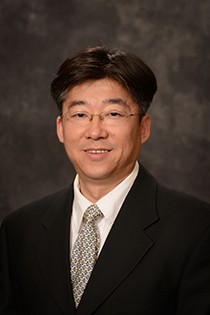May 29 2015
Texas A&M University mechanical engineering and materials science and engineering researchers led by Dr. Xinghang Zhang have discovered superior radiation tolerance of Cu with nanovoids and nanotwins. Their paper, entitled “Damage tolerant nanotwinned metals with nanovoids under radiation environments” was published in the April 2015 issue in Nature Communications.
 Dr. Xinghang Zhang
Dr. Xinghang Zhang
Material performance in extreme radiation environments is central to the design of future nuclear reactors. Radiation in metallic materials typically induces significant damage in the form of dislocation loops and continuous void growth, manifested as void swelling. In certain metallic materials with low-to-intermediate stacking fault energy, such as Cu and austenitic stainless steels, void swelling can be significant and lead to substantial degradation of mechanical properties.
By using in situ heavy ion irradiation in a transmission electron microscope (in collaboration with M.A. Kirk at IVEM facility at Argonne National Lab), Zhang’s student, Dr. Youxing Chen, reported a surprising phenomena: during radiation of nanotwinned Cu, preexisting nanovoids disappeared. The self-healing capability of Cu arises from the existence of three-dimensional coherent and incoherent twin boundary networks. Such a network enables capture and rapid transportation of radiation induced point defects and their clusters to nanovoids (as evidenced by in situ radiation experiments and molecular dynamics simulations performed in collaboration with Jian Wang at Los Alamos National Laboratory), and thus lead to the mutual elimination of defect clusters and nanovoids.
This study also introduces the concept that deliberate introduction of nanovoids in conjunction with nanotwins may enable unprecedented radiation tolerance in metallic materials. The mobile twin boundaries are swift carriers that load and transfer “customers” (defect clusters), and nanovoids are also necessary to accommodate these “customers.” The in situ radiation study also shows that after annihilation of nanovoids, the self-healing capability of nanotwinned Cu is degraded, highlighting the significance of nanovoids. The concept developed from this study, the combination of nanovoids with nanotwin networks, may also stimulate the design of damage tolerant materials in general that are subjected other extreme environments, such as high stress and high pressure impact.
Zhang is an associate professor in the Department of Mechanical Engineering at Texas A&M. His research group has expertise on radiation damage and nanomechanics in nanolayered and nanotwinned metals, as well as magnetic shape memory alloys.
Chen is a former Ph.D. student in Zhang’s group and joined the Los Alamos National Laboratory in May 2015. He received a bachelor's degree in materials science and engineering at Chongqing University in China, an master's degree in materials science at Shanghai Jiaotong University in China and a Ph.D. in materials science and engineering at Texas A&M. He is a recipient of the Distinguished Graduate Student Award by the Association of Former Students at Texas A&M, and has published more than 20 journal articles to date.
The other co-authors of this paper include Prof. Kaiyuan Yu (China Petroleum University); Drs. Yue Liu and S. Shao (postdocs at Los Alamos National Lab); Prof. Jian Wang (University of Nebraska-Lincoln, Lincoln); Dr. Haiyan Wang (Texas A&M) and Dr. Mark Kirk (Argonne National Laboratory). This research is supported by NSF-DMR-Metallic Materials and Nanostructures Program. The intermediate voltage electron microscopy (IVEM) facility at Argonne National Laboratory is supported by Department of Energy, Office of Nuclear Energy.